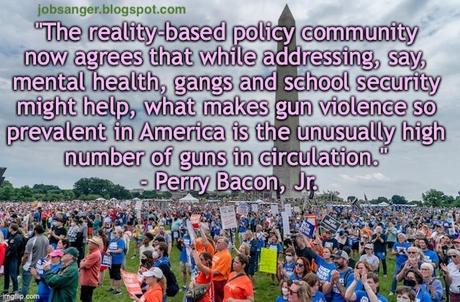
The Senate's "bipartisan" plan on gun violence will not succeed -- even if it is passed. That's because it doesn't address the real problems causing that violence. It does nothing to reduce the number of guns in our society (more than the total population), and the ability of anyone to buy any kind of gun they want. But things are changing in the country, and there is hope that real substantive change could happen in the near future.
The following op-ed is by Perry Bacon, Jr, in The Washington Post:
There is good news about gun policy in America. But it’s not the bipartisan agreement that emerged on Capitol Hill this week.
The deal between 10 Republican and 10 Democratic senators is better than nothing. But it amounts to small-bore measures that don’t really address the central problem — the broad availability and circulation of guns in the United States, including weapons such as the AR-15 that are often used in mass shootings. The danger is that passing this legislation will take the heat off lawmakers, particularly Republicans, to adopt truly meaningful solutions.
But ultimately, I don’t think passage of the Senate bill will weaken the push for more far-reaching gun policies. The recent mass shootings in Buffalo and Uvalde, Tex., have cemented two big, important shifts on gun policy that were already happening and won’t be slowed by the passage of a minor congressional bill.
First, those involved in public policy who are not accountable to hardcore Republican voters have come to agree that guns are the problem. As a result, many in the media, top Democratic Party officials, think tanks and advocacy groups that don’t usually focus on guns are all pushing for policies such as banning the sale and ownership of military-style weapons and high-capacity magazines. Just as significantly, the reality-based policy community now agrees that while addressing, say, mental health, gangs and school security might help, what makes gun violence so prevalent in America is the unusually high number of guns in circulation.
Centering guns as the problem unifies issues that are often discussed separately: mass shootings at schools and in other public spaces; shootings that happen among acquaintances or rival gangs; instances where people shoot spouses or partners; and suicides. It also brings together the groups and experts that work on those disparate problems to push for one solution — fewer guns.
The second big shift is that the national Democratic Party is no longer afraid of gun control. A mythology developed in the early 2000s that supporting gun control was a key driver of the Democrats’ decline in the South. In particular, some strategists argued that Al Gore lost his home state of Tennessee, and therefore the 2000 presidential election, over his support for gun control. Now, it’s fairly clear that the Democrats’ struggles in the South were part of a broader political realignment, with the most important explanation likely being Southerners breaking with the party as it became more tied to Black people and causes.
Also, electoral politics aside, the sheer number of catastrophic mass shootings over the past decade has basically forced Democrats to take on this issue.
These shifts aren’t reflected much in national policy, because the Democrats don’t have the Senate votes to push through a serious gun-control bill. But having a general agreement about the problem still matters. Why?
First, clearly identifying guns as the problem is a big step toward finding actual solutions. Now, wealthy individuals, organizations and the Democratic Party know they must develop a comprehensive agenda aimed at reducing the number of guns in the United States and only backing candidates who believe in that goal. The Biden administration, too, will have to keep pressing this issue, even when there are no clear political benefits. Whenever the Democrats next have control of the House, Senate and presidency, gun control must be at the top of the agenda, in a way that it wasn’t in 2009 or 2021.
Second, blue cities and states where Republicans aren’t a roadblock should pass strong gun regulations, daring lower-level GOP judicial appointees who are often hostile to local gun regulations to strike them down and thereby put gun rights ahead of public safety. Cities and states as well as philanthropic organizations should also seek innovative ways to encourage people to voluntarily either get rid of guns or not buy them in the first place. For example, I’m hoping we see public service announcements urging people against gun ownership, perhaps modeled on successful anti-smoking campaigns.
Third, understanding guns are the problem makes one solution imperative: demanding that GOP-appointed judges, including those on the Supreme Court, accept that some expansive gun-control measures are simply necessary for public safety. Conservatives on the court have essentially created a right for all Americans to own a handgun with few restrictions, a view some scholars say is not grounded in the original intent of the Second Amendment. The court’s conservatives are expected to further expand gun rights in a ruling still to come this term. America will continue to have constant shootings as long as we have such sweeping gun rights. If conservative justices don’t change course, the only answer will be judicial reforms such as adding justices to shift the balance of the court toward common-sense gun policy.
So, no, I’m not celebrating this bipartisan guns deal too much. But I am excited to see lots of powerful Americans, including top Democrats, get more serious about reducing the number of guns in the United States. That’s the only real solution — and it’s good that so many people are finally acknowledging that.

